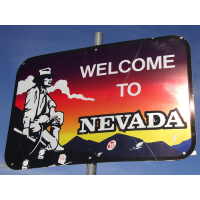California Loses Tesla Plant after Rejecting Environmental Degradation and Mega Tax Breaks

California had its chance to keep Palo Alto-based Tesla from agreeing to build a $5 billion battery Gigafactory in Nevada. All state lawmakers had to do was double the tax incentives, pony up hundreds of millions of dollars in advance and let the company skirt environmental regulations.
In the end, Nevada proved a much better place to receive those goodies and Tesla founder Elon Musk agreed to what Forbes called an “eye-popping deal” last week to build just outside of Reno. The package of incentives amounts to $1.25 billion over 20 years, compared to the roughly $500 million California was prepared to offer.
Forbes said it was the 10th largest package of investment incentives ever offered to a company. Around $725 million of assistance is in the form of a 20-year, 100% break from paying sales tax. The deal includes another $332 million in property tax abatement and an upfront $195 million worth of tax credits the company can sell. It is almost certain that Tesla will not be impeded by the kind of environmental standards it would face in California.
Nevada Governor Brian Sandoval said the deal would infuse $100 billion into the state economy during the contract’s duration and provide employment for 6,500 factory workers.
California was not considered a strong candidate early on for the factory, especially after Musk complained about the state’s high taxes. But the PayPal entrepreneur has strong connections to the state. He not only builds his Tesla cars in the state—and sells most of them here—his Space Exploration Technologies Company (Space X) that builds rocketships is headquartered in Los Angeles County’s city of Hawthorne.
Folks in California’s Imperial Valley belatedly thought they had a shot at landing the factory because a company, Simbol Materials, was planning to start construction of a plant that will use an innovative process to extract lithium from the nearby Salton Sea. Lithium is a key material in batteries used by many electric cars.
Tesla is building the battery plant in anticipation of launching its Model 3 sedan in 2017. The car would sell for $35,000-$40,000, about half the price of its Model S.
California lawmakers tried to pass legislation that would have cleared the way to offer Tesla incentives, but Senate Bill 1309 never got as far as a committee vote despite being co-sponsored by Senate leader Darrell Steinberg (D-Sacramento).
Governor Jerry Brown and some lawmakers were willing to fast track the legislation, allowing the factory to bypass critical elements of the California Environmental Quality Act (CEQA), which requires a detailed environmental impact report. Criticism of the proposal went beyond complaints that the deal would make a mockery of the state’s landmark environmental law.
“For one thing, it does indicate that we have two systems of law in California—one for the super rich, and one for the developer doing multifamily housing,” Natural Resources Defense Council lawyer David Pettit told the Los Angeles Times.
Others worried that it would put green endeavors like electric cars in a bad light, implying that the technology is economically unfeasible and can’t compete without handouts from government.
That is a common complaint from fans of oil and coal who think alternative energy producers can’t compete in the marketplace—the one where governments regularly subsidize every paleo form of energy production on the planet.
–Ken Broder
To Learn More:
Tesla Reportedly Chooses Nevada for Big Factory; California Falls Short (by Dale Kasler, Sacramento Bee)
Tesla Picks Nevada for Massive Battery Factory (by Sammy Roth, The Desert Sun)
Inside the Eye-Popping Deal Nevada Offered to Land Tesla's $5 Billion Gigafactory (by Micheline Maynard, Forbes)
Dear Tesla: Bypassing Environmental Laws Is Bad for Everyone (by Robert Sorokanich, Gizmodo)
Tesla Mines Gold in Silver State (by Jerry Hirsch, Chris Kirkham and Marc Lifsher, Los Angeles Times)
- Top Stories
- Controversies
- Where is the Money Going?
- California and the Nation
- Appointments and Resignations
- Unusual News
- Latest News
- California Forbids U.S. Immigration Agents from Pretending to be Police
- California Lawmakers Urged to Strip “Self-Dealing” Tax Board of Its Duties
- Big Oil’s Grip on California
- Santa Cruz Police See Homeland Security Betrayal in Use of Gang Roundup as Cover for Immigration Raid
- Oil Companies Face Deadline to Stop Polluting California Groundwater





